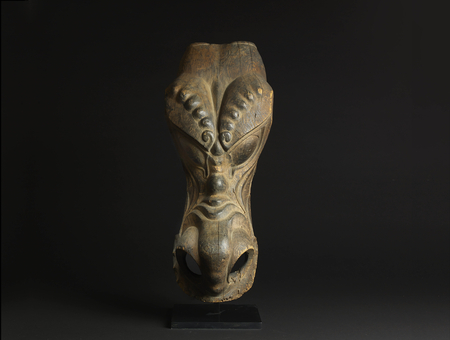Product Description
7133 A carved wood bamen (mask for horses) mould in the form of a dragon’s head
Japan 16th century Muromachi/Momoyama period
Dimensions: H.21¼” x W.8¾” (53.5cm x 22cm)
This representation of a dragon’s head is very similar in type to other masks depicting shihsi (lion dogs). These masks are used in the lion dance which arrived in Japan together with Buddhism around the seventh century AD.
As lions were not indigenous to Japan, at first representations were based on those of Tang dynasty China. Gradually, however, the lion, or shishi, developed a uniquely Japanese appearance. The mask with a textile body was worn or carried by one or more performers leading Buddhist gyōdo processions to exorcise evil along the route. Various dances involving masks have been used in all forms of drama since then, including Bugaku, Gigaku, Nō, Kabuki, and especially kagura festivals.
New Year celebrations in particular involved a lion-dance (dai-kagura) to dispel misfortune and sometimes involving fire-preventive rituals. A form of the shishi dance was also performed by the yamabushi (mountain warrior monks), adherents of the syncretic form of Shintō and Buddhism called Shugendō, practised in the mountains of Dewa province (present-day Yamagata and Akita prefectures).
Like the other kagura masks, the shishi is sometimes placed in a ritual position and remains static during the ceremony in which it becomes occupied by the deity of the shrine. Notable features of the shishi mask include a prominent nose, moveable lower jaw, a mane lying forward over the head, and very small ears.
In the traditional cosmology of China, the dragon is one of the Four Sacred Creatures, representing the east, heaven, sunrise, spring, rain, and the male element. Dragons are a traditional subject-matter of kanga, or the Chinese painting style, and were often painted on large format surfaces such as ceilings and walls.
The eastern dragon is not the gruesome monster of medieval imagination, but rather the genius of strength and goodness. He is the spirit of change, wielding the power of transformation, and possesses the gift of rendering himself visible or invisible at will. Hidden in the caverns of inaccessible mountains, or coiled in the unfathomed depths of the sea, the dragon awaits the spring when he slowly rouses himself into activity. He unfolds himself in the storm clouds; he washes his mane in the blackness of the seething whirlpools, and ascends into the skies. Emerging in the spring, the dragon announces by his awakening the return of nature’s energies, when by means of genial rains and storms all nature renews itself. In the autumn he covers himself in mud and buries himself once more in the watery depths.
For an example of a shishi mask showing similar features see: The British Museum Collection ref. Asia JA 1999.12-19.87, AN36357001





